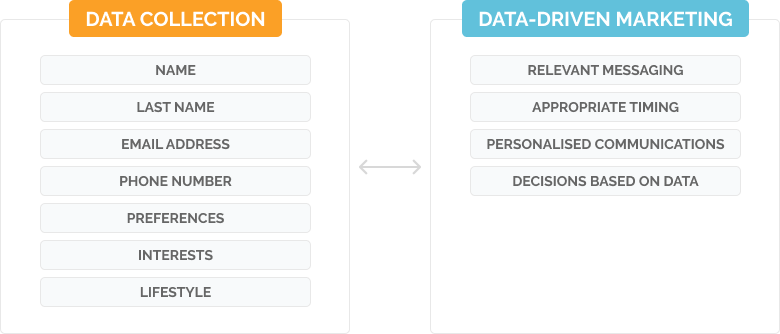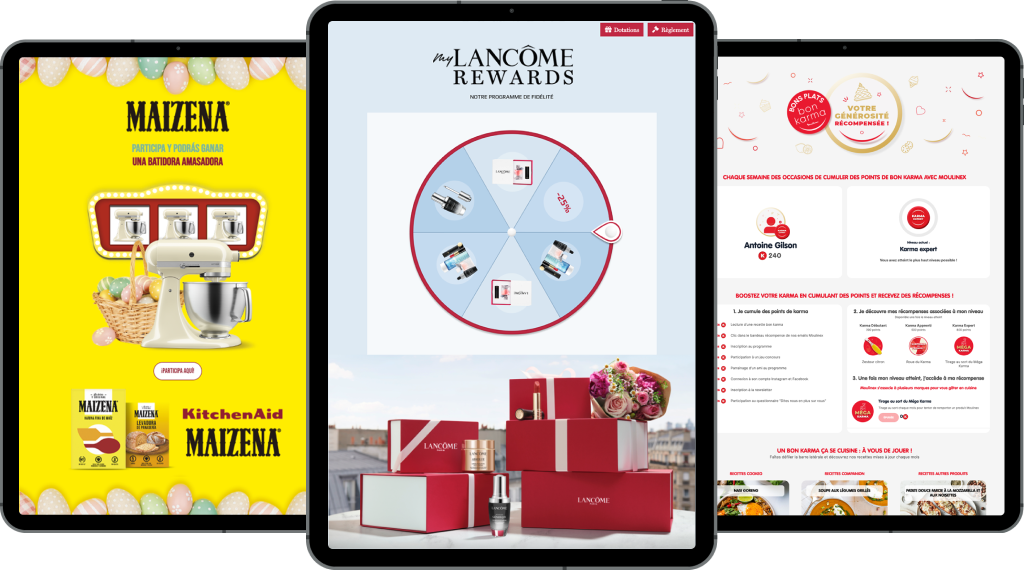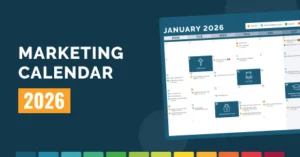How to engage and monetise your audience with data-driven marketing
In this article, we’ll discuss the concept of data-driven marketing and its growing importance for modern brands. We include topics such as:
- What is data-driven marketing
- The benefits and challenges of a data-driven marketing strategy
- How to collect data for your data-driven marketing strategy
- Real examples of how top brands succeed with data-driven marketing
The rules of the game have changed for marketers. Guessing your audience’s interests and needs no longer works. Today’s audiences expect to connect with brands in more profound ways and feel understood. To achieve this, brands need access to valuable customer data.
In this article, we explore the concept of data-driven marketing, why it matters, and how it has become not just common but essential for brands aiming to succeed in a competitive, digital-first world.
What is data-driven marketing?

Data-driven marketing is the practice of gathering, analysing, and activating customer data to shape smarter marketing actions and decisions. With access to measurable customer data, brands can tailor their marketing campaigns to specific customer segments and individuals, creating personalised experiences that lead to:
- Increased ROI
- Boosted sales
- Enhanced engagement
- Lasting customer loyalty
Instead of launching generic, one-size-fits-all campaigns, a data-driven marketing strategy allows you to deliver the right message to the right person, at the right time, based on data rather than assumptions.
Two key types of data for data-driven marketing
A successful data-driven marketing strategy can’t exist without access to the right types of customer data. The two most valuable types of data are:
- First-party data, such as an individual’s name or phone number, is provided to carry out a process or purchase.
- Zero-party data, such as personal interests, preferences, or lifestyle insights, is information that is not easily inferred unless individuals proactively share it.
First-party data can help a brand identify a member of their audience and add them to its database. For example, Mary, a 35-year-old woman who lives in Brussels. Zero-party data might reveal that she’s passionate about sustainability and beauty products, and that she prefers online shopping.
By collecting and combining first- and zero-party data about individual members of their audience, brands can create enriched data profiles, segment users effectively, and deliver content and offers that are tailored to their unique interests.
What are the benefits of data-driven marketing?
By definition, data-driven marketing involves making informed marketing decisions based on actual data about the audience. With access to both identification details and interest insights from each of your customers, you can leverage their data for the benefit of your business.

Increase your marketing ROI
One of the most significant advantages of implementing a data-driven marketing strategy for your business is the increase in marketing return on investment (ROI). Customer data allows you to:
- Identify which types of campaigns resonate best with different audience segments
- Track campaign performance over time and channels (clicks, conversions, open rates, etc.)
- Optimise spending by focusing on high-performing channels and reducing it for low performers
Example: an email campaign gets significantly more clicks than the same campaign as a website ad, allowing you to reallocate your budget to your email efforts and positively impact your ROI.
Boost your sales
Personal data can help you not only identify your audience members, but also their interests and what drives them to make decisions. Through this data, brands can personalise each individual’s customer journey, triggering targeted marketing actions at the right moment and maximising their impact. Rather than spamming with generic promotions, brands can personalise their marketing actions based on personal data that boosts their impact.
Example: a logged-in user browses kitchen appliances on your site, allowing you to send a tailored email communication moments later, including offers or discounts on products they have just viewed, thereby increasing their likelihood of making a purchase.
Enhance customer engagement
In a sea of advertising and brand communications, audiences and consumers tend to tune them out. But nothing to worry about, because personalised and relevant interactions can break through the noise ⚡️
In this context, customer data allows you to:
- Segment your audience based on their behaviour, interests, demographics, etc.
- Personalise your content, from remembering their birthday to sharing about their preferred products
- Deliver marketing campaigns that feel relevant rather than intrusive or spammy
Interactive marketing campaigns (such as gamified contests, quizzes, polls, or reward programs) have not just become one of the most effective tools to collect first- and zero-party data from audiences. They also aim to provide users with a moment of fun and a memorable experience that strengthens their connection with the brand.
Example: a beauty brand ships Christmas product samples to a consumer segment with an interest in skincare. This small yet meaningful gift will make consumers feel understood and appreciated at a special time of the year, as well as more connected to your brand during that period and beyond.
Build a loyal customer base
In human relationships, loyalty can’t be bought: it must be earned through trust and consistency. In the marketing world? It’s pretty much the same!
A data-driven marketing strategy can help you build that loyalty with your audience. Here’s how:
- Be transparent: when you collect customer data, for instance, via forms in interactive marketing campaigns, state clearly why you’re collecting data and what for.
- Use opt-ins: allow your customers to consent to specific uses of their data and to subscribe to your newsletter voluntarily.
Stay active: remain connected proactively with your audience through targeted marketing actions and communications, focusing on what’s relevant to each person without overcommunicating.
Reward programs are an excellent marketing tool for building customer loyalty and staying connected over time. They encourage members to interact with your content recurrently, earning points and striving to redeem exclusive rewards.

Members can earn points by:
- Signing up and providing their contact information
- Participating in interactive marketing campaigns that boost engagement and collect further data
- Watching videos or reading content
- Inviting their friends to join
Reward programs keep your audience coming back to interact with your content, and snatch those precious rewards, keeping your brand present continuously.
What are common challenges in data-driven marketing?
While the benefits of data-driven marketing for modern businesses are clear, some challenges still exist, and it’s crucial to avoid them from the birth of your data-driven marketing strategy.
Data silos
When customer data is scattered across different teams and software (siloed data), it becomes hard to access and act on, standing in the way of an effective data-driven marketing strategy.
Ensure that you collect data using a platform that can be easily integrated with your other software. This way, you can ensure your data is immediately available across platforms after you collect it.
Low data quality
Incomplete, outdated, or inconsistent data can misinform your data-driven marketing actions, risking wasting your budget on the wrong audience or sending irrelevant messages. How can you avoid this?
- Collect data in a standardised format
- Use data validation tools to check email addresses and phone numbers in real time
- Regularly clean your database to remove outdated personal profiles
Privacy and compliance concerns
Data privacy has taken a turn for the better in the past decades. Regulations like the GDPR have established new standards and requirements for data collection, shaping how businesses collect and use customer data and giving individuals control over their information.
At the same time, users have become more aware of the value of their personal data and the importance of being cautious about sharing it haphazardly. As a business that collects customer data, it is essential that you:
- Be transparent about why you collect data and how you will use it
- Make it easy for users to manage their data preferences
- Respect user requests to access, modify, or delete their data
- Use data collection platforms that are inherently GDPR-compliant
Whether you already have a data-driven marketing strategy in place or are looking to implement one, don’t forget to address these three challenges early on!
- Choosing the right data collection platform
- Collecting precise and high-quality data
- Stay compliant from the start
Taking these steps will prevent you from having to do extra work down the road and help you maximise the effectiveness of your data-driven marketing strategy.
How to collect customer data?
A successful data-driven marketing strategy must be based on collecting high-quality, consented data and making this data available to your marketing software.
Collecting first- and zero-party data, voluntarily shared by your audience, is essential in the process, allowing you to:
- Identify individual members of your audience by their name, email, etc.
- Enrich your database with their preferences and interests
- Personalise your marketing campaigns for each individual
- Segment your whole audience and target effectively with relevant content
Qualifio is the leading European first- and zero-party data collection platform for brands. We enable marketing teams to get to know their audiences through interactive and gamified experiences, offering compelling reasons for ongoing engagement.

With Qualifio, you can collect the much-needed audience data to fuel a successful, data-driven marketing strategy. Here’s how Qualifio can help:
- Create interactive marketing campaigns with our catalogue of 50+ formats: quizzes, arcade games, surveys, gamified landing pages, Advent calendars, and more.
- Build your campaigns quickly and independently, without needing technical skills, and publish them on all your digital channels.
- Create powerful forms and opt-ins to include in your campaigns, collecting first- and zero-party data with consent and GDPR compliance.
- Integrate Qualifio with your other marketing tools, and make data available to them instantly.
Enrich your database continuously by collecting data through reward programs and gamified pages over time.
Real examples of successful data-driven marketing from top brands
Curious how leading brands are collecting and using actionable data from their audiences? Here are just a few examples!
How L’Oréal brands collect data across Europe

Dozens of L’Oréal brands across Europe use Qualifio to collect data from their audiences and drive their data-driven marketing strategies. In just one year:
- They launched 700 interactive marketing campaigns to engage their audiences and collect their data
- These campaigns attracted 5.5. million participants, who registered on L’Oréal websites and shared their data
- Campaign participants often provided preferences like skincare needs, enabling brands to offer highly relevant product recommendations
Thanks to this data, these L’Oréal brands not only expanded their consumer database with new individuals but also enriched their consumer profiles with zero-party data, enabling a more precise segmentation and enhancing their data-driven marketing.
How Unidad Editorial monetise readers through data

Unidad Editorial, one of the major players in the Spanish media landscape, launches daily interactive marketing campaigns in their newspapers. Remarkably, sports newspaper Marca attracts over 40 million participations annually!
Through quizzes and other interactive marketing formats tied to editorial content, Unidad Editorial’s brands:
- Collect valuable zero-party data, related to reader preferences, opinions, and interests in general.
- Better segment their registered readers using information such as their interests to provide relevant content.
- Monetise their readers through advertisers, targeting individuals with ads that they’re likely to be interested in.
In this case, customer data not only helps build loyalty through presenting individuals with tailored content, but it also helps Unidad Editorial’s brands enhance their collaboration with advertisers while profiting from it.
How Moulinex understand consumers with a reward program

Moulinex is a leading brand in the small household appliance industry, and part of French giant Groupe SEB.
The brand runs a reward program created with Qualifio to engage consumers and collect valuable data:
- Users register by submitting their personal details, including their name and email address.
- They earn points for their actions in the program: inviting friends, reading recipes, participating in interactive marketing campaigns, and more.
- Those points can be redeemed for exclusive rewards, incentivising members to return to the program often for more points.
With their program, Moulinex not only boost repeated engagement with consumers, but also continuously collect zero-party data from each member. A direct result? Program members spend twice as much money online as the average consumer.
Want to learn how other brands in your industry use Qualifio to collect data for their data-driven marketing? Discover their strategies in our success stories, or check our monthly articles with great campaigns created by our users.
Final thoughts
Practising data-driven marketing has become the standard for modern businesses. By collecting customer data ethically and with a clear purpose, brands can expand their customer database and gain a deeper understanding of their customers at the individual level. This data is key for personalising marketing actions, which result in a stronger relationship with brands and an increased ROI.
Therefore, it all starts with collecting the correct data in the right way, using data collection platforms that help you gather audience insights and make them available to your other marketing platforms for activation.
If you’re looking to launch interactive campaigns that both engage users and collect high-quality, GDPR-compliant customer data, our platform is built for precisely that. Let us help you turn data into your competitive edge.







